| |
Monday, September 24, 2007, 4:01 PM GeneralPosted by matthew After many months, it was brought to our attention that our blog looked like crap on Internet Explorer. I think it's fixed now. In general, we want and expect things to look right on every browser — so if you see something that looks wrong, please tell us!
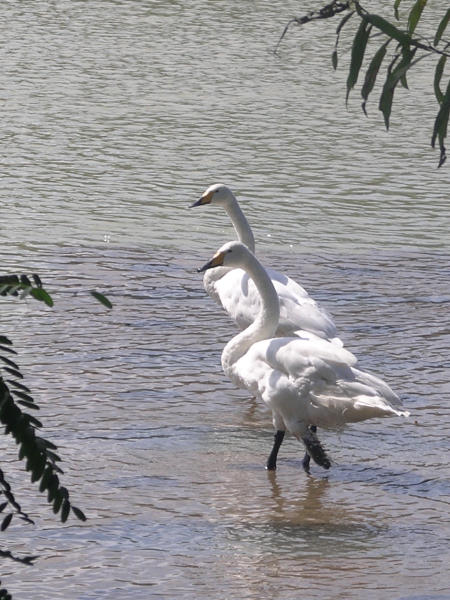 Kitakami is at least a little famous for its swans. This is actually a recent development, or so we're told. I guess swans migrate through here, and about five or six years ago, a couple of swans somehow got broken wings. Since they could not fly, their whole family (six swans) decided to make their home here year round. You can see the broken wing on the one in front.
 Wherever you go in Japan, it seems you are never far from a Shinto shrine. They are everywhere, tucked between houses in residential areas, on a hillside in the country, or in a narrow space between hotels in the heart of Tokyo. Every day on my way to work, I pass this medium-sized one with well-kept grounds. It's on a strip of land about twenty feet wide, between a parking lot on the left and a house on the right.
 Not too subtle, is it? I wonder if they respect intellectual property rights. Don't forget, today is International Talk Like a Pirate Day. Shiver me timbers!
Tuesday, September 18, 2007, 2:04 AM General, FoodPosted by stefanie Autumn is coming to Kitakami. I know this because the Daily Yamazaki has been touting "Autumn's Good Flavor Fair."  I couldn't tell you what the DY is contributing in terms of good flavor because the odor drove me out before I had a chance to fully contemplate the offerings. It smelled like the Wheaton Dunkin' Donuts at 3:30 in the morning on a Saturday — phoo! Autumn does seem to be prime cooking season in Japan. Kaki (persimmons) will be ripe for picking soon, mushrooms and chestnuts are peaking, and rice harvest is just around the corner. Plus, chill nights and cool mornings invite steaming bowls of rice and udon. Last week, I made my first autumn dish: miso-simmered mackerel alongside some genmai (brown rice) bought from Matthew's rice-farmer student. He and his wife had also given us some kind of a chili relish to go on the rice that tastes like nothing we've ever had before, but is totally addictive. It has that certain je ne sais Nihon that many foods here do — some essentially Japanese flavor that is rarely, if ever, found abroad.
The Right Tool for the Job
As they say, if your only tool is a chainsaw hammer, every problem starts to look like a summer camp nail.  We decided to splurge and get some ingredients to make burritos ($9 for a pack of tortillas and a can of beans?!), but forgot that we didn't have a can opener. For the record, the hammer didn't work. Faced with the choice between burritos without beans and going out into the rain to get a can opener ― well, it wasn't much of a choice, really. I got wet, and we had beans.
Okay, there isn't actually a llama here. But there are ducks, and they always make me think of the song. 
[ 3 comments ] permalink
Saturday, September 15, 2007, 1:28 AM GeneralPosted by stefanie Japanese is a hard language to learn, between the three writing systems used simultaneously and the fact that kanji can have multiple pronunciations and meanings depending on the context. Nevertheless, studying it is great fun. I've learned approximately fifty kanji by now, which is a drop of the drop in the bucket that one should have to get along well in Japan. Matthew knows about a hundred. We recognize many others from having seen them over and over again, but we don't really know them — like, we can't write them, pronounce them, or tell you what they mean. But we enjoy making things up. Mostly, I enjoy making things up.
For example, there used to be a city in Akita Prefecture named Omagari. In Japanese, Omagari looks like this: 大曲. The first character means "big." I don't know what the second is, but I know what I think it looks like. To me, Omagari is "big factory."
Matthew and I have a few posters of Japanese characters hanging up in our study. We had the following conversation about them the other day:
SKD (pointing): 元 looks like pi.
MAD: Actually, I think 刀 looks more like pi.
SKD: Maybe you're right. Hee, 刀 is near 当. Pi is near cake. (Doesn't it look like a slice of birthday cake with candles on top?)
MAD: This one means electric. 電. It's a dragon pulling lightning from the rain clouds. (The top part of the character is the kanji for rain.)
SKD: Cool. Oh hey, snow! 雪. It's rain on top of cake!
MAD: It's rain that falls in layers.
SKD: Layers — like cake!
Our Japanese teachers would be so proud.
[ 2 comments ] permalink
Thursday, September 13, 2007, 1:51 PM TrainsPosted by matthew Why you should always have a camera readyWalking the dogs this morning, I got a special treat: the new shinkansen prototype came by on a test run. JR East doesn't publish the test schedule, but they do notify neighborhoods along the line of what days (and nights) they'll be running test trains. Today they are running the Fastech 360 S test train between Sendai and Hachinohe. Alas, I don't always carry a camera with me. I probably wouldn't have had time to turn the camera on and take a picture anyway.
Wednesday, September 12, 2007, 1:29 PM GeneralPosted by matthew Friday's typhoon brought lots of rain, not just here, but also upstream from here. So, the Waga river rose — a lot. I took this picture on August 27, because I was impressed at how high the water level was. It was deep and fast. There are two tiers of tetrapods here. The lower level, which usually looks about like the upper level does in this shot, is nearly submerged. The concrete posts in the foreground are probably about four feet high. 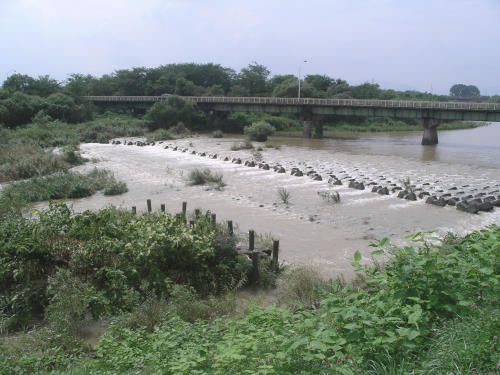 Here's the scene on Saturday morning, after the typhoon. The little nubs you can see in the river (just to the right and below the center of the photo) are the tops of the concrete posts. 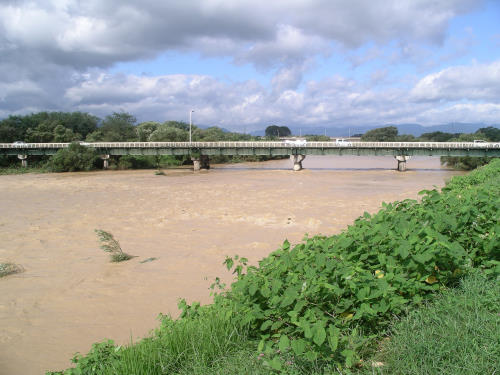 Although the water was impressively high on Saturday, it was down several feet from its highest point. The park where we walk the dogs was underwater sometime on Friday, but we didn't see it. We did see the neat line of grass clippings running along the hill, marking the highest water level. 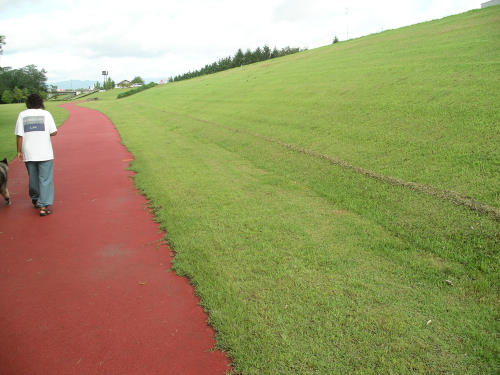 By the time we were there, the water had receded pretty far — but not far enough that we could walk our regular course! 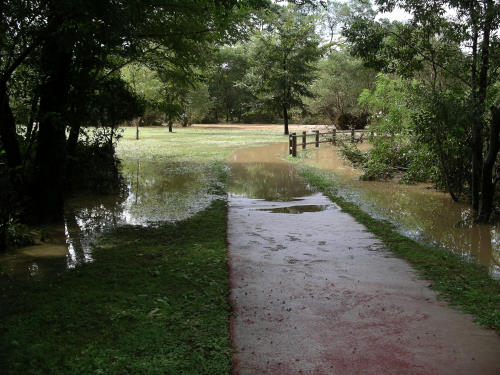 The water level has continued to go down since then, and now it's almost back to the level in the first photo.
Back Next
|
|










 Calendar
Calendar




